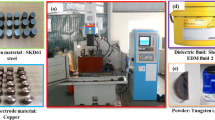Abstract
In the recent century, tools for machining, forming, or other types of metalworking industries have consumed several tons of steel materials. Although the earliest tool steels were plain carbon steels, the modern tools contain different alloying elements, like tungsten, vanadium, molybdenum, manganese, and chromium, to provide the properties desired for their wide applications. The presence of a large number of such tool steel materials is a result of the fact that no single material combines the maximum wear resistance, toughness, machinability, safety in hardening, and non-deformability properties. Each tool steel material has its own mechanical and physical characteristics that help it to be suited for a particular application. Also for a specific application, more than one alternative tool steel material may exist, which makes it essential to select the most appropriate tool steel material with the desired properties to meet the manufacturer’s requirements. This paper considers a list of ten tool steel materials whose performances are evaluated based on nine selection criteria. Preference ranking organization method for enrichment evaluation (PROMETHEE II) is then applied to solve this tool steel material selection problem to obtain the full ranking of the considered material alternatives. Molybdenum-type high-speed steel (AISI M2) and tungsten base high-speed tool steel (AISI T1) are the two best choices. Alloy steel (AISI 4140) is the worst preferred tool steel material.
Similar content being viewed by others
References
Bryson B (1997) Heat treatment, selection and application of tool steels. Hanser Gardner, Ohio
Kalpakjian S, Schmind RS (2004) Manufacturing engineering and technology. Pearson Education Inc., Singapore
Boyes WE (1989) Handbook of jig and fixture design. SME, Michigan
Wang M-JJ, Chang TC (1995) Tool steel materials selection under fuzzy environment. Fuzzy Sets Syst 72:263–270
Chen SM (1997) A new method for tool steel materials selection under fuzzy environment. Fuzzy Sets Syst 97:265–274
Kumar S, Singh R (2007) A short note on an intelligent system for selection of materials for progressive die components. J Mater Process Technol 182:456–461
Caiyuan L, Jianjun L, Jianyong W, Xiangzhi X (2001) HPRODIE: using feature modeling and feature mapping to speed up progressive die design. Int J Prod Res 39:4133–4151
Towhidi N, Tavakkoli-Moghaddam R, Vahdat SE (2005) The use of fuzzy logic theory for selecting appropriate tool steels with price analysis. Iranian J Sci Technol Trans B Eng 29:559–567
Calıskan H, Kursuncu B, Kurbanoğlu C, Güven SH (2013) Material selection for the tool holder working under hard milling conditions using different multi criteria decision making methods. Mater Des 45:473–479. doi:10.1016/j.matdes.2012.09.042#doilink
Shirai K, Murakami H (1985) Development of a CAD/CAM system for progressive dies. CIRP Ann 34:187–190
Prasad YKDV, Somasundaram S (1992) CADDS: an automated die design system for sheet metal blanking. Comput Control Eng 3:185–191
Huang K, Ismail HS, Hon KKB (1996) Automated design of progressive dies. Proc Inst Mech Eng B J Eng Manuf 210:367–376
Ismail HS, Hon KKB, Huang K (1993) CAPTD: a low-cost integrated computer aided design system for press tool design. Proc Inst Mech Eng B J Eng Manuf 207:117–127
Cheok BT, Foong KY, Nee AYC, Teng CH (1994) Some aspects of a knowledge-based approach for automating progressive metal stamping die design. Comput Ind 24:81–96
Kumar S (2011) An intelligent system for selection of materials for press tool components. J Eng Res Stud 2:119–130
Doumpos M, Zopounidis C (2004) A multi-criteria classification approach based on pair-wise comparison. Eur J Oper Res 158:378–389
Silva V, Morais D, Almeida A (2010) A multicriteria group decision model to support watershed committees in Brazil. Water Resour Manag 24:1–17
Doumpos M, Zopounidis C (2010) A multicriteria decision support system for bank rating. Decis Support Syst 24:4075–4091
Luk J, Fernandes H, Kumar A (2010) A conceptual framework for siting biorefineries in the Canadian Prairies. Biofuels Bioprod Bioref 4:408–422
Rao RV, Patel B (2010) Decision making in the manufacturing environment using an improved PROMETHEE method. Int J Prod Res 48:4665–4682
Roy B, Bouyssou D (1993) Multi-criteria decision: methods and cases. Economica, Paris
Brans JP, Mareschal B, Vincke P (1984) PROMETHEE: A new family of outranking methods in multicriteria analysis. In: Brans JP (ed) Operational Research IFORS 84, 1st edn. North Holland, Amsterdam, pp 477–490
Brans JP, Vincke P, Mareschal B (1986) How to select and how to rank projects: the PROMETHEE method. Eur J Oper Res 24:228–238
Brans JP, Vincke P (1985) A preference ranking organisation method: the PROMETHEE method for MCDM. Manag Sci 31:647–656
Hajkowicz S, Higgins A (2008) A comparison of multiple criteria analysis techniques for water resource management. Eur J Oper Res 184:255–265
Chen T, Wang YC, Tsai HR (2009) Lot cycle time prediction in a ramping-up semiconductor manufacturing factory with a SOM-FBPN-ensemble approach with multiple buckets and partial normalization. Int J Adv Manuf Technol 42:1206–1216
Davis JR (1996) ASM specialty handbook —carbon and alloy steels. American Society for Metals, Ohio
Boyer HE, Gall TL (1985) Metals handbook. American Society for Metals, Ohio
SAE ferrous materials standards manual (1999). Society of Automotive Engineers Inc., Pennsylvania
The Sousa Corp ‘Technical’ (2012) Tool steel properties. http://www.sousacorp.com/tool1.htm# HIGH SPEED TOOL STEELS. Accessed on 30 November, 2012
Simply Tool Steel ‘Data Sheets’ (2011) http://www.simplytoolsteel.com/CPM-3V-tool-steel-data-sheet.html. Accessed on 30 November, 2012
Rao RV (2007) Decision making in the manufacturing environment using graph theory and fuzzy multiple attribute decision making methods. Springer, London
Author information
Authors and Affiliations
Corresponding author
Rights and permissions
About this article
Cite this article
Maity, S.R., Chakraborty, S. Tool steel material selection using PROMETHEE II method. Int J Adv Manuf Technol 78, 1537–1547 (2015). https://doi.org/10.1007/s00170-014-6760-0
Received:
Accepted:
Published:
Issue Date:
DOI: https://doi.org/10.1007/s00170-014-6760-0




